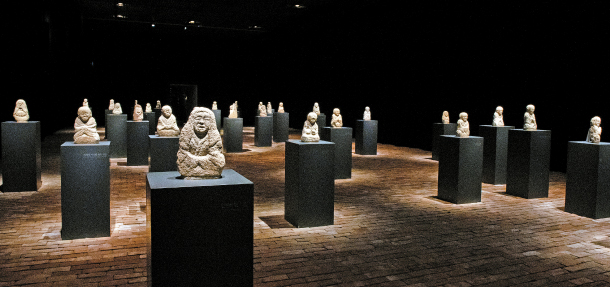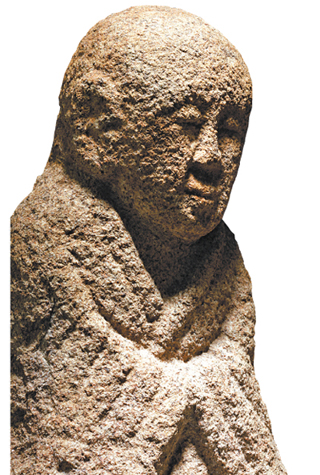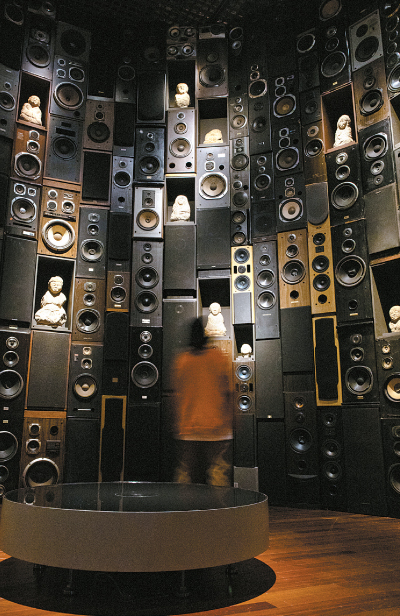Cultural heritage meets contemporary art: National Museum of Korea exhibit displays Goryeo era statues uncovered in 2001

The first section of the “Five Hundred Arhats of Changnyeongsa Temple Site: Reflection of Our Hearts” exhibit that is currently ongoing at the National Museum of Korea in central Seoul. [NATIONAL MUSEUM OF KOREA]
This is the beginning of the “Five Hundred Arhats of Changnyeongsa Temple Site: Reflection of Our Hearts” exhibition that kicked off at the National Museum of Korea late last month. These statuettes are known as Arhats, or luohan, in Buddhism, which refers to those who have gained enlightenment. They are one of the historical disciples of Buddha. The exhibit features 88 Arhat statues with lifelike expressions. Not all of them are smiling though, as some show expressions of anger and sorrow.

Among them, 64 were in complete form while the rest were discovered with the heads separated from the bodies. The site was revealed to be the location of the Changnyeong Temple during the Goryeo Dynasty (918-1392) - a roof tile with Chinese characters for Changnyeongsa (Changnyeong Temple) was also discovered during the excavation, along with other Goryeo celadons. The temple is mentioned in the 1481 book “Dongguk Yeoji Seungnam,” or Augmented Survey of the Geography of Korea.
“Before the excavation [of this site], the existence of the Changnyeong Temple was unknown,” said Choi Seon-ju, head of Asian Arts Division at the museum. “The site had been called a temple site of Changwon-ri. But thanks to the discovery, we were able to assume that it was the Changnyeong Temple site that enshrined 500 Arhats.”
According to Choi, Arhats in East Asian Buddhist art appear in groups of 6, 8, 16, 100 or 500 and that the Changnyeong Temple is presumed to have held 500 Arhats.
Park Kyung-eun, who curated the exhibition, said some of the statuettes were exposed to heat, suggesting that they were created in late Goryeo or early Joseon Dynasty (1392-1910) and were destroyed during the Joseon Dynasty when Neo-Confucianism became dominant in the country.
Because these Buddhist figures were discovered in Chuncheon, they were first revealed to the public through an exhibition that kicked off last August at the Chuncheon National Museum in Gangwon. The exhibition attracted about 30,000 people to the museum and was selected as “The Exhibition of the Year” in 2018 by the National Museum of Korea.

The “Arthats of Daily Introspection” section shows contemporary artist Kim Seung-young’s tower-like installation and the Arhats. [NATIONAL MUSEUM OF KOREA]
The exhibit is largely divided in two sections. The first part, “The Faces of the Arhats: Between the Earthly and the Saintly” section, displays 32 Arhats each placed on pedestals erected in a dark room with a brick floor. To offer visitors a sense of walking in a forest, contemporary artist Kim Seung-young, who worked on the design of the exhibition, created pedestals reminiscent of trees and added sounds of birds chirping.
To make sure the Seoul exhibition offers something different from the exhibition in Chuncheon, Kim added a new section.
The “Arthats of Daily Introspection” section stands in contrast to the first nature section, reminding visitors of an urban environment. Kim used a total of 700 speakers to make the tower-like installation and placed 29 Arhat statues among them to create a “scene where old historical figures harmoniously meet contemporary art.”
The sounds of water dripping and bells resonate as visitors walk around the tower.
“The Arhat statuettes are from the past,” Kim said, “but the expressions on their faces are so universal, or even modern … I think this installation shows the harmony between cultural heritage and contemporary art.”
BY YIM SEUNG-HYE [sharon@joongang.co.kr]
The exhibit runs until June 13. The entrance fee is 3,000 won ($2.50). The museum opens at 10 a.m. and closes at 6 p.m. on weekdays, except on Wednesdays when it opens until 9 p.m. During weekends and public holidays, the museum closes at 7 p.m. For more information, call (02) 2077-9045 or visit www.museum.go.kr










with the Korea JoongAng Daily
To write comments, please log in to one of the accounts.
Standards Board Policy (0/250자)